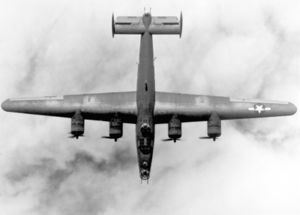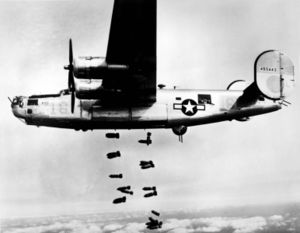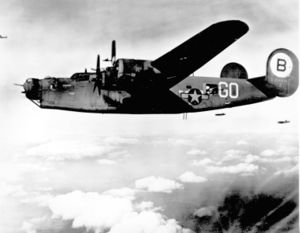PlaneSpottingWorld welcomes all new members! Please gives your ideas at the Terminal.
B-24 Liberator
| B-24 Liberator | |
|---|---|
| U.S. Army Air Force Consolidated Liberator over Maxwell Field, Alabama. | |
| Type | Strategic (heavy) bomber |
| Manufacturer | Consolidated Aircraft |
| Designed by | Isaac M. Laddon |
| Maiden flight | 29 December 1939 |
| Introduced | 1941 |
| Retired | 1945 |
| Primary users | United States Army Air Force United States Navy Royal Air Force |
| Produced | 1940-1945 |
| Number built | 18,482 |
| Unit cost | $297,627[1] |
| Variants | PB4Y Privateer XB-41 C-87 Liberator Express R2Y |
The Consolidated B-24 Liberator was an American heavy bomber that was produced in greater numbers than any other American combat aircraft during World War II and was used by most of the Allied air forces during the war, attaining a distinguished war record with its operations in the European, Pacific, African and Middle Eastern theaters. Often compared to its more famous partner, the Boeing B-17, the B-24 was a more modern design with a higher top speed, greater range and service ceiling yet it had a similar bombload and massive defensive armament. Nevertheless, popular opinion among aircrews and general staff tended to favour the B-17's rugged qualities above all other considerations.[2]
Where the B-24 excelled over other contemporary World War II heavy bombers was in its versaltility.[3] Designed around a highly-efficient "Davis" wing design, one of the B-24's main virtues was a long operating range, which led to it also being used for other duties including maritime patrol (known as the PB4Y in US Navy service) and antisubmarine work, reconnaissance, tanker, cargo (where it was designated C-87 and C-109, and also developed into the Navy's R2Y) and personnel transport. Winston Churchill used one as his own transport aircraft. One of the most valuable contributions to Allied victory was the use of the B-24 in combating the U-boat menace in the North Atlantic. When the "very-long-range" Liberators were unleashed on the vulnerable submarines, a so-called "Atlantic Gap" was ultimately closed, allowing Britain's convoy lifeline to be maintained.[4]
Contents
Design and development
The Liberator's origins stem from a USAAC request in 1938 for Consolidated to produce the B-17 under license as part of the "Project A" program for industrial expansion and production to supplement the manufacturing of key components of air power.[5] After company executives including President Reuben Fleet visited the Boeing factory in Seattle, a decision was made to submit a more modern design instead.[6] In January 1939, the United States Army Air Corps formally invited Consolidated Aircraft under Specification C-212,[7] to submit a design study for a bomber with greater range, higher speed and greater ceiling than the B-17.
The contract for a prototype was awarded in March, with the requirement that a prototype be ready before the end of the year. The design was simple in concept but advanced for its time. Compared to the B-17 Flying Fortress, the proposed Model 32 was shorter, had 25% less wing area but a six foot (1.8 m) greater wingspan and a substantially greater carrying capacity. Whereas the B-17 used 9-cylinder Wright R-1820 Cyclone engines, the Consolidated design would use twin-row 14-cylinder Pratt & Whitney R-1830 Twin Wasp radials of 1000 hp (746 kW). The 70,547 lb (32,000 kg) maximum takeoff weight was one of the highest of the period. Consolidated also incorporated innovative features: the new design would be the first American bomber to use tricycle landing gear and it had long, thin wings with the efficient "Davis" high aspect ratio design promising to provide maximum fuel efficiency. The aircraft also had a distinctive twin tail and rudder assembly.
Due to the sophisticated design elements, wind tunnel testing and experimental programs utilizing an existing Consolidated Model 31, a twin-engined commercial flying boat, provided extensive data on the flight characteristics of the Davis airfoil.[8]
A spacious slab-sided fuselage was built around a central bomb bay that could accommodate up to 8000 pounds of bombs. The bomb bay was divided into front and rear compartments and further divided by a central catwalk, which was also the fuselage keel beam. A universal complaint arose from the extremely narrow catwalk. The plane was sometimes disparaged as "The Flying Coffin" because the only entry and exit from the plane was in the rear and it was almost impossible for the flightcrew and nose gunner to get from the flight deck to the rear if they were wearing their parachutes. An unusual set of "roller-type" bomb bay doors retracted into the fuselage with a minimum of aerodynamic drag.[9]
Consolidated finished the prototype, by then known as the XB-24, and had it ready for its first flight two days before the end of 1939. Seven more YB-24 development aircraft flew in 1940 and Consolidated began preparing production tooling.[10]Early orders — placed before the XB-24 had flown — included 36 for the United States Army Air Corps, 120 for the French Armée de l'Air and 164 for the RAF. Most of the first production B-24s went to Britain, including all those originally ordered by the Armée de l'Air after France collapsed in 1940. The name, "Liberator" was initially assigned to the RAF and subsequently was adopted by the USAAC as the official name for the type.[11]
Operational history
Initial deployment
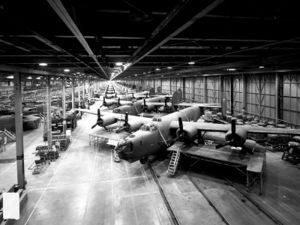
The first deployment of the Liberator exploited its long-range capabilities as US ferry pilots to the United Kingdom, were returned home in March 1941. The LB-30 variant serving in the British Overseas Airways Corporation on trans-Atlantic transport duties soon were involved in assorted transport duties.[12] The most indispensable role for the first batch of the Liberator Mk 1 equipped with ASV Mark II radar was in service with RAF Coastal Command where its long range "almost doubled the reach of Britain's maritime reconnaissance force" </ref>[13] on anti-submarine patrols in the Battle of the Atlantic.[14]
Later in 1941, the first Liberator IIs entered service. This model introduced self-sealing fuel tanks and powered gun turrets. At the same time, Consolidated added a 2 ft 7 in (79 cm) plug in the forward fuselage to create more space for crew members and also (it is said) to make the airplane look better.[citation needed] Liberator IIs were split between RAF Coastal Command, RAF Bomber Command and the British Overseas Airways Corporation. Two RAF squadrons subsequently were deployed to the Middle East in 1942 in the first use of the Liberator as a bomber.[15]
At the same time, the United States Army Air Forces began to take delivery of its first B-24As. Like the British, they used them as transports first. Continued development work by Consolidated produced a handful of transitional B-24Cs with turbocharged instead of supercharged engines; the turbocharged engines led to the flattened oval nacelles that would distinguish all subsequent Liberator models.
The first mass-produced model, the B-24D (or Liberator III in British service) was introduced in early 1943; it had turbocharged engines and increased fuel capacity. Three more 0.50 caliber (12.7 mm) M2 machine guns brought the defensive armament up to ten machine guns. At 59,524 lb (27,000 kg) maximum takeoff weight, it was one of the heaviest aircraft in the world; only the British Lancaster and Halifax bombers were comparable.
America enters the war
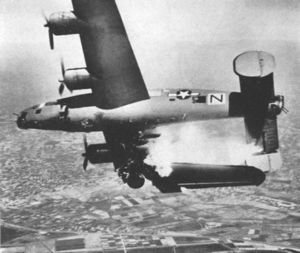
American B-24s entered combat in June 1942 with a raid of 13 aircraft on the German-occupied Romanian oilfields of Ploieşti launched from Egypt. The attack was described as "unsuccessful" by the Army but it alerted the defenders to the threat of the new heavy bombers. When 177 B-24s attacked Ploieşti again on 1 August 1943, 54 failed to return.
Liberator production increased at an astonishing rate through 1942 and 1943: Consolidated had tripled the size of its plant at San Diego and built a large new plant outside Fort Worth, Texas. More production came from Douglas in Tulsa, Oklahoma and North American was building a plant at Dallas, Texas. None of these were minor operations, but they were dwarfed by the vast new greenfield factory built by Ford at Willow Run near Detroit, which opened in August 1942. This was the largest factory in the United States, and the largest anywhere outside the USSR.
In April 1942, the C-87 Liberator Express transport version entered production at Fort Worth. It had a large cargo door, no gun turrets, a floor in the bomb bay for freight and side windows. Liberator squadrons deployed to all theaters: Africa, Europe, the Atlantic, India and the Pacific. In the Pacific, the B-24 was designated the standard heavy bomber to simplify logistics, replacing the shorter-range B-17, which had not distinguished itself in the Pacific Theater.
In 1943, the model of Liberator considered by many the "definitive" version was introduced. The B-24H was 10 inches (0.25 m) longer, had a powered gun turret in the nose to reduce vulnerability to head-on attack and was fitted with an improved bomb sight, autopilot and fuel transfer system. Consolidated, Douglas and Ford factories all manufactured the model, while the version made in Dallas by North American was designated the B-24G. All five plants switched over to the almost identical B-24J in August 1943. The later B-24L and B-24M were lighter weight versions and differed mainly in defensive weaponry.
As the war went on, the complexity of servicing the B-24 grew greater and greater. Since B-24s were made by a number of different companies, repair depots had to keep a large stock of many kinds of parts to supply various B-24 models. Fortunately, in the summer of 1944, this problem was eased when three plants stopped making B-24s, leaving only the Consolidated plant in San Diego and the Ford plant in Willow Run.
In all, 18,482 Liberators were built by September 1945. In addition to the twelve thousand that saw service with the United States Army Air Forces, the Royal Air Force flew about 2,100 aircraft in 46 bomber groups and 41 squadrons, the Royal Canadian Air Force 1,200 B-24Js, the U.S. Navy about 1,000 PB4Y-1s (and almost 800 PB4Y-2 Privateers, which were derived from the Liberator) and the Royal Australian Air Force (RAAF) 287 B-24Js, B-24Ls and B-24Ms — (Liberators were the main heavy bomber used by the RAAF in the Pacific). Two squadrons of the South African Air Force deployed in the Mediterranean flew B-24s.
Primary roles
Maritime Patrol
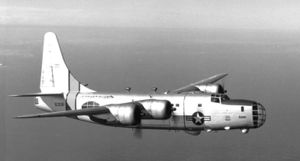
The Liberator made a massive contribution to the Battle of the Atlantic. The decision to allocate early Liberators to RAF Coastal Command produced results immediately. The Very Long Range (VLR) Liberator closed the vital Atlantic Gap and was the only aircraft with the range to do so. The VLR sacrificed some armour and often turrets for weight whilst adding extra fuel in bomb bay tanks. Radar and the Leigh light gave them the ability to hunt U-boats by day and night. They were operated from both sides of the Atlantic with the RCAF to the west and the RAF from the UK and Iceland. However, B-24s remained vulnerable to attack, especially after many U-boats were armed with Flak guns and adopted a policy of staying on the surface to fight. Royal New Zealand Air Force pilot Lloyd Allan Trigg was awarded a posthumous Victoria Cross following such a duel, off the coast of West Africa. Trigg's Liberator and its crew were lost, as was their foe, U-468. Trigg's VC is the only one ever awarded on the recommendation of enemy personnel — the seven U-boat crew members who survived.
Later models were more capable of surviving over occupied Europe or Axis fighters but because of the extra weight allocated to their defense, they had a shorter range. Nothing was done to improve or replace the patrol aircraft until late in the war when the U-boat threat was waning. For twelve months, No. 120 Squadron RAF of Coastal Command, with its handful of much patched and modified early model Liberators, supplied the only air cover for convoys in the Atlantic Gap, even while shipments of B-24s to strategic bombing squadrons doubled and redoubled. The sudden and decisive turning of the Battle of the Atlantic in the Allies' favor in May 1943 was the result of many factors. However, it was no accident that it coincided with the long delayed arrival of many more VLR Liberators for maritime patrol. Liberators were credited in full or part with 72 U-boat kills. In addition to very long range patrols, the B-24 was vital for patrols of a radius less than 1,000 mile (1,609 km), in both the Atlantic and in the Pacific where B-24s and PB4Y-1s took a heavy toll of Japanese shipping.
Transport
Early model Liberators were used as unarmed long-range cargo carriers. They flew between Britain and Egypt (with an extensive detour around Spain over the Atlantic) and were used in the evacuation of Java. This success led to the development of dedicated transport models, known variously as the C-87 Liberator Express, RY-2 or Liberator Cargo VII. The U.S. only made about 300 transports (as compared with over 18,000 other versions) but they were nevertheless the backbone of the Army Air Force’s heavy transport operation. The C-87 was not popular with the crews forced to fly them. The planes had a distressing habit of losing cockpit electrical power on takeoff and landings, engine reliability left something to be desired and the pilots were disconcerted at the Davis wing's habit of flexing at high altitudes. In his autobiography, Fate is the Hunter, author Ernest K. Gann reported, while flying cargo in India, he barely avoided crashing a C-87 into the Taj Mahal.
The US Army Air Force also converted 218 B-24Ds and B-24-Es into C-109 tankers. These tankers were used in all theaters but they were particularly used to fly fuel from India over the Himalayas to supply B-29 bases in China. With all armour and military equipment removed to save weight, a C-109 could carry almost 2905 gal (11,000 L) of fuel — over 22,000 lb (10,000 kg). In addition, a large number of unmodified B-24s were pressed into transport duties. Qantas Empire Airways used Liberators on the Perth-Colombo route, at the time the longest non-stop route in the world, until they were replaced by Avro Lancastrians.
The second LB-30 version supplied to Britain was finished as a VIP transport and used by Winston Churchill as his personal aircraft.
Variants and conversions
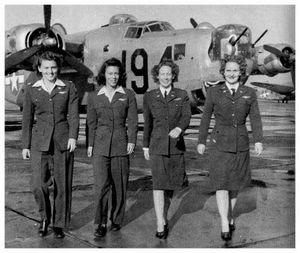
US Army Air Force Variants
- XB-24— (Consolidated Model 32). Designed in 1938 as an improvement on the B-17 Flying Fortress, at the request of the Army Air Corps. It had a wing specially designed for a high aspect ratio, tricycle landing gear, and twin vertical stabilisers. The XB-24 was ordered in 1939 March, and first flew on 29 December 193. (Total: one)
- YB-24/LB-30A- Preproduction prototypes. Six examples were sent to Great Britain under lend-lease, under the designation LB-30A.
- B-24 - Service test version of the XB-24, ordered on 27 April 1939, less than 30 days after the XB-24 was ordered, before the XB-24 design was complete. A number of minor modifications were made: elimination of leading edge slots, addition of de-icing boots. (Total: seven; only one used for actual testing)
- B-24A/LB-30B - Ordered in 1939, the B-24A was the first production model. Due to the need for heavy bombers, the B-24A was ordered before any version of the B-24 flew. The main improvement over the XB-24 was improved aerodynamics, which led to better performance. Some sent to Great Britain under Lend Lease as LB-30B. (Total: 38,20 LB-30Bs, nine B-24Cs)
- XB-24B - When the XB-24 failed to reach its projected top speed, the Pratt & Whitney R-1830-33 radials rated at 1,000 hp (746 kW) it carried were replaced with R-1830-41 turbo-supercharged radials rated at 1,200 hp (895 kW), increasing its top speed by 37 mph (59 km/h). The addition of the turbo-superchargers made the engine cowlings elliptical. The XB-24B version also lacked the engine slots of the original. (Total: one converted XB-24)
- B-24C - Conversion of the B-24A using turbo-supercharged R-1830-41 engines. To hold the supercharger and the intercooler intake, the cowlings were made elliptical and the new items added on the sides. The tail gunner position was improved by adding an Emerson A-6 power turret with twin .50-caliber (12.7 mm) machine guns; a Martin power turret was added to the forward fuselage. (Total: nine converted B-24As)
- B-24D - First model produced on a large scale; ordered from 1940 to 1942, as a B-24C with better engines (R-1830-43 supercharged engines). During the production run, the tunnel gun in the belly was replaced by a remote-sited Bendix belly turret; this was later replaced by a Sperry ball turret. In late B-24Ds, 'cheek' guns were added. (Total: 2696, 2381 Consolidated, San Diego; 305 Consolidated, Fort Worth, ten Douglas, Tulsa, Oklahoma)
- B-24E - A slight alteration of the B-24D built by Ford, using R-1830-65 engines. Unlike the B-24D, the B-24E retained the tunnel gun in the belly. Sometimes the Martin top turret was removed and a Bendix chin turret added. Ford also built sub-assemblies for Douglas; these subassemblies were identical to Ford-built B-24Es, except that they used the same engines as the B-24D (R-1830-43 radials). (Total: 801)
- XB-24F - A prototype made to test thermal de-icers, instead of the standard inflatable rubber "boots." (Total: one converted B-24D)
- B-24G - Sperry ball turret, three .50-calibre (12.7 mm) machine guns in nose. All B-24Gs were built by North American Aviation, which was contracted in 1942. (Total: 25)
- B-24G-1 - Modified Emerson A-6 tail turret in nose instead of two- three .50 caliber (12.7 mm) machine guns in earlier models. The B-24G-1 was based on the design of the B-24H (Total: 405)
- B-24H - Because of obvious vulnerability of the B-24 to head-on attack, the B-24H design made by Ford used a nose turret, generally a modified Emerson A-6 tail turret. The entire aircraft was redesigned to better fit the turret; 50 airframe changes were made, including a redesigned bombardier compartment. The tail turret was given larger windows for better visibility, the top turret a higher bubble, and the waist gunner positions were offset, to reduce their interference during battle. (Total: 3100)
- B-24J - The B-24J was very similar to the B-24H, although the defensive improvements made in the B-24H were not incorporated in the B-24J. The B-24J featured an improved autopilot (type C-1) and a bombsight of the M-1 series. B-24H subassemblies made by Ford and constructed by other companies and any model with a C-1 or M-1 retrofit, were all designated B-24Js. (Total: 6678)
- XB-24K - An experimental aircraft, made by Ford by splicing a B-23 Dragon tail empennage onto a B-24D airframe. The plane was more stable and had better handling than other models, but changing the B-24 design was too expensive to do at the time. However, the XB-24K was the ancestor of the Navy's PB4Y-1. (Total: one converted B-24D)
- B-24L - Because of the immense weight of the B-24J, the Army pushed for a lighter version. In the B-24L, the ball turret was replaced by a floor ring mount with two .50 calibre (12.7 mm) machine guns, and the A-6B tail turret by an M-6A. In later aircraft, no tail armament was installed, and when it arrived at its airfield, either an A-6B, an M-6A, or a dual-mount manual .50-caliber (12.7 mm) gun was field-installed. (Total: 1667)
- B-24M - An enhancement of the B-24L with further weight-saving devices. The B-24M used a more lightweight version of the A-6B tail turret; the waist gunner positions were left open. For better visibility, the windshield was replaced by a "knife-edge" dual pane versions. The B-24M became the last production model of the B-24; a number of the planes built flew only the course between the factory and the scrap heap. (Total: 2593)
- XB-24N - A redesign of the B-24J, made to accommodate a single tail. It also featured improved nose and tail turrets. While 5168 B-24Ns were ordered, World War II ended and there was no longer any need for them. (Total: one)
- YB-24N - Pre-production service test version of the XB-24N. (Total: seven)
- XB-24P - A modified B-24D, made by Sperry Gyroscope Company to test airborne fire control systems. (Total: oneconverted B-24D)
- XB-24Q - A General Electric conversion of the B-24L, using radar-controlled tail turrets. (Total: one converted B-24L).
- XB-41 - Because there were no fighters capable of escorting bomber formations on deep strike missions early in World War II, the Army authorised tests for heavily armed bombers to act as escorts for bombing missions. It was completed in 1942. The results of 1943 testing were very negative and the project was quickly cancelled. Performance changed drastically with the addition of more turrets. The escorts were also unable to keep up with bomber formations once the bombs had been dropped.
The XB-41 had fourteen .50-calibre (12.7 mm) machine guns, through the addition of a Bendix chin turret and a dorsal Martin power turret on the mid-fuselage. (Total: one converted B-24D) - AT-22 or TB-24 - C-87 used for flight engineer training.
- RB-24L - Developed for training B-29 gunners on an identical remote gun system installed on a B-24L.
- TB-24L - As with the RB-24L, but with additional radar equipment.
- C-87 Liberator Express - Passenger transports with accommodation for 20 passengers.
- C-87A - VIP transports with R-1830-45 instead of -43 engines and sleep accommodations for 16 passengers.
- C-87B - Projected armed transport variant with nose guns, dorsal turret, and ventral tunnel gun; never produced.
- C-87C - US Army Air Force/Air Force designation for the RY-3.
- XC-109/C-109 - Tankers with specialized equipment to help prevent explosions, used to ferry fuel from India to China to support initial B-29 raids against Japan.
- XF-7 - Photographic reconnaissance variant developed from the B-24D.
- F-7 - Photographic reconnaissance variant developed from the B-24H; -FO block.
- F-7A - Photographic reconnaissance variant developed from the B-24J; three cameras in the nose and three in the bomb bay.
- F-7B - Photographic reconnaissance variant developed from the B-24J; six cameras in the bomb bay.
- PB4Y-1 - B-24D with different nose turret for US Navy.
- PB4Y-1P - Photographic reconnaissance variant developed from the PB4Y-1.
- PB4Y-2 Privateer - See Main Article
- RY-1 - US Navy designation for the C-87A.
- RY-2 - US Navy designation for the C-87.
- RY-3 - Transport variant of the PB4Y-2.
British Nomenclature and subvariants
- Liberator B Mk I - B-24A (Total: 20), used in British Coastal Patrol and Defense Squadrons.
- Liberator B Mk II - Improved LB-30 (Total: 165)
- Liberator B Mk III - B-24D variant with single .303 Browning machine gun in the nose, two in each beam position, and four in a Boulton Paul tail turret similar to that on the Lancaster, as well as, other British equipment. The Martin dorsal turret was retained. (Total: 156)
- Liberator B Mk IIIA - Lend-Lease B-24Ds with American equipment and weapons.
- Liberator B Mk IV - Reserved for the B-24E, but there is no record of the RAF actually receiving any.
- Liberator B Mk V - B-24D modified for extra fuel capacity at the cost or armor, with the same armament fit as the Liberator Mk III.
- Liberator B Mk VI - B-24Hs in RAF service fitted with Boulton Paul tail turrets, but retaining the rest of their armament.
- Liberator B Mk VIII - RAF designation for B-24Js.
- Liberator GR Mk V - B-24D modified by RAF Coastal Command for the anti-submarine role with search radar and Leigh Light. Some were fitted with 8 zero-length rocket launchers, four on each wing.
- Liberator GR Mk VIII - B-24J modified by RAF Coastal Command for the anti-submarine role.
- Liberator C Mk VI - Liberator B Mk VIII converted for use as a transport.
- Liberator C Mk VII - British designation for C-87.
- Liberator C Mk VIII - Liberator G Mk VIII converted for use as a transport.
- Liberator C Mk IX - RAF designation for the RY-3/C-87C.
Units using the Liberator
United States Army Air Forces
At peak inventory, the USAAF had 6,043 B-24 Liberators operating world-wide in September 1944.
- Fifth Air Force
- Seventh Air Force
- Eighth Air Force
- Ninth Air Force
- Tenth Air Force
- Eleventh Air Force
- Thirteenth Air Force
- Fourteenth Air Force
- Fifteenth Air Force
American Senator and presidential candidate George McGovern served as a B-24 pilot in missions over Italy as a member of the 455th Bomb Group of the Fifteenth Air Force; his wartime exploits and some of the characteristics of the B-24 are the focus of Stephen Ambrose's book The Wild Blue.
Brigadier General Jimmy Stewart USAF Reserve, flew B-24s as commanding officer of the 703rd BS, 445th BG out of Tibenham, U.K., before a promotion to operations officer of the 453rd BG.
The book One Damned Island After Another (1946) contains the official history of the 7th Bomber Command of the Seventh Air Force. It describes B-24 operations in the Central Pacific. B-24s from the Seventh Air Force were the first B-24s to bomb the Japanese home islands.
Former Speaker of the House, Jim Wright, served as a B-24 bombardier in the Pacific. He recounts his experience in his book "The Flying Circus: Pacific War--1943--as Seen Through a Bombsight".
Royal Air Force
- No. 8 Squadron RAF
- No. 102 Squadron RAF
- No. 120 Squadron RAF - the most successful of the anti-submarine squadrons with 14 U-boat kills.
- No. 200 Squadron RAF
- No. 206 Squadron RAF
- No. 223 Squadron RAF
- No. 224 Squadron RAF
- No. 233 Squadron RAF
Royal Australian Air Force
Squadrons
- No. 12 Squadron RAAF
- No. 21 Squadron RAAF
- No. 23 Squadron RAAF
- No. 24 Squadron RAAF
- No. 25 Squadron RAAF
- No. 99 Squadron RAAF
- No. 102 Squadron RAAF
Independent special duties flights
- No. 200 Flight RAAF (controlled by the Allied Intelligence Bureau)
- No. 201 Flight RAAF
Others
- Template:BRA
- Template:CAN
- Template:ROC
- Template:CHN
- Template:CZS
- Template:FRA
 Germany: Luftwaffe (captured)
Germany: Luftwaffe (captured)- Template:IND
- Template:ITA
- Template:NLD
- Template:NZL
- Template:POL: Polish Air Forces in exile (No. 301 Polish Bomber Squadron)
- Template:POR
- Template:USSR
 South Africa: SAAF
South Africa: SAAF- Template:TUR
Survivors
A partial list of surviving airframes includes:[16]
- B-24D, (former USAAF #41-23908) is in restoration (on indoor display) at the Hill Aerospace Museum, Hill AFB in Roy, Utah.
- B-24D (former USAAF #41-24311) is on static display as "Hadley's Harem" (reputed to have a war record and flew Ploesti raid) in Istanbul, Turkey.
- B-24D, (former USAAF #42-72843) is on static display as "Strawberry Bitch" at the National Museum of the United States Air Force, Wright-Patterson, Ohio.
- B-24J (former USAAF #44-44175/former IAF aircraft HE-877/N7866) is on static display as "Bungay Buckaroo" at the Pima Air & Space Museum, Tucson, Arizona.
- B-24J, (former USAAF #44-44213/former IAF aircraft HE-924) is on static display at India Air Force Museum, Palam (located near New Delhi), India.
- B-24J, (former USAAF #44-44272/former IAF aircraft KH-401) is on static display at Kermit Weeks Fantasy of Flight, Polk, Florida, USA.
- B-24J-85-CF, (former USAAF #44-44052/ former IAF aircraft T-18) is flown by the Collings Foundation, currently painted as "Witchcraft."
- B-24J, (former USAAF #44-48781) is on static display as "Louisiana Belle II" at the Eighth Air Force Museum, Barksdale AFB, Louisiana.
- B-24L-20, (former USAAF #44-50154/former IAF aircraft HE-773) is on static display as Liberator GR VIII at Canada Aviation Museum, Ottawa, Ontario, Canada.
- B-24L-20, (former USAAF #44-50206/former IAF aircraft HE-807) is on static display at RAF Museum, Hendon, London, UK.
- B-24M, (former USAAF #44-41906) is on static display as "The Blasted Event" at Castle Air Museum, Atwater, California.
- B-24M, (former USAAF #44-51228) is on outdoor static display at USAF History and Traditions Museum, Lackland AFB, San Antonio, Texas.
- B-24M-10-CO, (former USAAF #44-41956 and RAAF A72-176) is being restored at Werribee, Victoria, Australia. [4]
- LB-30B, (former Consolidated company aircraft #AM-927) is now flying as "Diamond Lil" as part of the Commemorative Air Force collection. [5]
Specifications (B-24J)
Data from Quest for Performance[17]
General characteristics
- Crew: 7-10
- Length: 67 ft 8 in (20.6 m)
- Wingspan: 110 ft 0 in (33.5 m)
- Height: 18 ft 0 in (5.5 m)
- Wing area: 1,048 ft² (97.4 m²)
- Empty weight: 36,500 lb (16,590 kg)
- Loaded weight: 55,000 lb (25,000 kg)
- Max takeoff weight: 65,000 lb (29,500 kg)
- Powerplant: 4× Pratt & Whitney R-1830 turbosupercharged radial engines, 1,200 hp (900 kW) each
- * Zero-lift drag coefficient: 0.0406
- Drag area: 42.54 ft² (3.95 m²)
- Aspect ratio: 11.55
Performance
- Maximum speed: 290 mph (250 knots, 470 km/h)
- Cruise speed: 215 mph (187 knots, 346 km/h)
- Stall speed: 95 mph (83 knots, 153 km/h)
- Combat radius: 2,100 mi (1,800 nm, 3,400 km)
- Ferry range: 3,700 mi (3,200 nm, 6,000 km)
- Service ceiling: 28,000 ft (8,500 m)
- Rate of climb: 1,025 ft/min (5.2 m/s)
- Wing loading: 52.5 lb/ft² (256 kg/m²)
- Power/mass: 0.0873 hp/lb (144 W/kg)
- Lift-to-drag ratio: 12.9
Armament
- Guns: 10× .50 in (12.7 mm) M2 Browning machine guns
- Bombs:
- Short range (≈400 mi): 8,000 lb (3,600 kg)
- Long range (≈800 mi): 5,000 lb (2,300 kg)
- Very long range (≈1,200 mi): 2,700 lb (1,200 kg)
- Bombloads used in practice: Maximum Reported B-17 & B-24 Bomb Loads
References
- ↑ Consolidated B-24 Liberator
- ↑ Birdsall 1968, p. 3.
- ↑ Winchester 2004, p. 56.
- ↑ Winchester 2004, p. 57.
- ↑ Green 1975, p. 83.
- ↑ Taylor 1969, p. 462.
- ↑ Baugher, Joe. The Consolidated XB-24. USAAC/USAAF/USAF Bombers. [1] Access date: 16 February 2007.
- ↑ Birdsall 1968, p.40.
- ↑ Green 195, p. 84.
- ↑ Wagner 1968, p. 127-128.
- ↑ Taylor 1968, p. 463.
- ↑ Taylor 1968, p. p. 463.
- ↑ Green 1975, p. 85.
- ↑ Winchester 2004, p. 57.
- ↑ Birdsall 1975, p. 5.
- ↑ [2] Note: List primarily derived from Aviation Enthusiast Corner (Consolidated B-24 Liberator file)
- ↑ Loftin, L.K. Jr. Quest for Performance: The Evolution of Modern Aircraft. NASA SP-468. [3]. Retrieved on 22 April 2006.
- Birdsall, Steve. The B-24 Liberator. New York: Arco Publishing Company, Inc., 1968. ISBN 0-668-01695-7.
- Birdsall, Steve. B-24 Liberator In Action. Carrollton, Texas: Squadron/Signal Publications, 1975. ISBN 0-89747-020-6.
- Birdsall, Steve. Log of the Liberators. New York: Doubeday, 1973. ISBN 0-385-03870-4.
- Bomber Aircraft Virtual Gallery. Dayton, OH: National Museum of the USAF. [6] Retrieved on 13 October 2004.
- Consolidated B-24 Liberator. Encyclopedia of American Aircraft [7] Retrieved on 13 October 2004.
- Gann, Ernest K. Fate Is The Hunter. New York: Simon & Shuster, 1986. ISBN 0-671-63603-0.
- Green, William. Famous Bombers of the Second World War. New York: Doubleday & Company, 1975. ISBN 0-385-12467-8.
- Job, Macarthur. Misadventure at Mauritius. Flight Safety Magazine, January - February 2000. [8] Retrieved on 3 December 2005.
- Johnsen, Frederick A. Consolidated B-24 Liberator (WarbirdTech Volume 1). North Branch, Minnesota: Specialty Press, 2001. ISBN 1-58007-054-X.
- O'Leary, Michael. Consolidated B-24 Liberator. Botley, UK: Osprey Publishing, 2002. ISBN 1-84176-023-4.
- Taylor, John W. R. "Consolidated B-24/PB4 Y Liberator." Combat Aircraft of the World from 1909 to the present. New York: G.P. Putnam's Sons, 1969. ISBN 0-425-03633-2.
- Wagner, Ray. American Combat Planes. New York: Doubleday & Company, Inc., 1968. ISBN 0-385-04134-9.
- Winchester, Jim. "Consolidated B-24 Liberator." Aircraft of World War II: The Aviation Factfile. Kent, UK: Grange Books plc, 2004. ISBN 1-84013-639-1.
External links
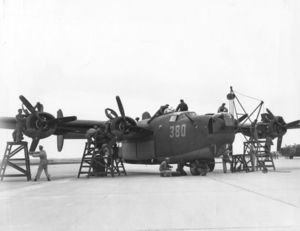
B-24 Aircraft
- B-24 Best Web - Image Archive and Research/Reference Center
- The Collings Foundation - Last operable B-24
- The B-24 Liberator
- Warbird Alley: B-24 page - Information about B-24s still flying today
- SP-468 Quest for Performance: The Evolution of Modern Aircraft, NASA
B-24 "Specific" - Air Force / Bomb Group / Bomb Squadron
Naval Variant: PB4Y-1 "Liberator" (Split Tail) / PB4Y-2 "Privateer" (Single Tail)
Related content
Related development
- B-32 Dominator
- C-87 Liberator Express
- C-109 Liberator
- PB4Y Privateer
- XB-41 Liberator
- Consolidated R2Y
Comparable aircraft
- Heavy 4-Engine piston bombers aircraft of the early 1940s:
- British: Avro Lancaster, Handley-Page Halifax, Short Stirling, Vickers Windsor
- German:Focke-Wulf Fw 200, Junkers Ju 290
- Other: B-17 Flying Fortress, Petlyakov Pe-8, Piaggio P.108B
Designation sequence
- Consolidated: 29 - 30 - 31 - 32 - 33 - 34 - 35
- Pre-1948 USAAC/F:
- Bomber: XB-21 - XB-22 - B-23 - B-24 - B-25 - B-26 - XB-27
- Bomber: XB-38 - XB-39 - YB-40 - XB-41 - XB-42 - XB-43 - XB-44
- Photographic Reconnaissance: F-4 - F-5 - F-6 - F-7 - F-8 - F-9 - F-11
- Advanced Trainer: AT-19 - AT-20 - AT-21 - AT-22 - AT-23 - AT-24 - AT-25
- Transport: C-84 - C-85 - C-86 - C-87 - C-88 - C-89 - C-90
- Transport: - C-106 - C-107 - C-108 - XC-109 - C-110 - C-111 - C-112
- 1922-1962 Navy :
- Post-1948 USAF:
- Great Britain
Related lists
See also
Lists relating to aviation | |
|---|---|
| General | Timeline of aviation · Aircraft · Aircraft manufacturers · Aircraft engines · Aircraft engine manufacturers · Airports · Airlines |
| Military | Air forces · Aircraft weapons · Missiles · Unmanned aerial vehicles (UAVs) · Experimental aircraft |
| Notable incidents and accidents | Military aviation · Airliners · General aviation · Famous aviation-related deaths |
| Records | Flight airspeed record · Flight distance record · Flight altitude record · Flight endurance record · Most produced aircraft |
cs:B-24 Liberator de:Consolidated B-24 fr:Consolidated B-24 Liberator it:Consolidated B-24 Liberator nl:B-24 Liberator ja:B-24 (爆撃機) pl:Consolidated B-24 Liberator pt:B-24 Liberator sl:Consolidated B-24 Liberator fi:B-24 Liberator sv:B-24 Liberator
